With Street Food: Latin America Netflix aims at bringing some Latin American flavors to living rooms around the world. However, its representation of the Central and Southern American countries and populations through their food traditions is triggering mixed reactions due to its poor representation of the complexities shaping those cultures.
Limited Representation
The mini-documentary series features six episodes—Argentina, Brazil, Bolivia, Peru, Colombia, and Mexico—leaving out twenty-seven countries (here you can read the full list), and some viewers are already looking forward to a second season covering a wider range of countries.
At first glance, the visuals look great. The countries covered by the show stretch out to most of Central and South America. However, by focusing on the widest countries only and identifying their cultures with those of their major cities, they defy the documentary’s very goal, i.e., to lend representation to the smaller, marginal actors working in the culinary world and to recognize the diversity and complexity contributing to those cultures.
Twitter’s had a lot of buzz about the show, so I created an algorithm to mine it and get to the bottom of it.
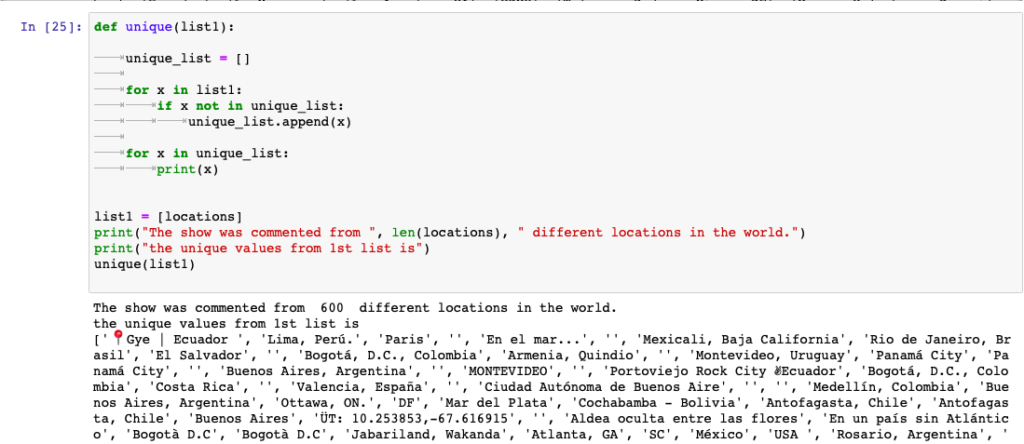
So far, people have commented on the show from 600 different locations around the world, ranging from Central and South America to North America to Europe (Bulgaria, France, Germany, Italy, and Spain) to Australia. Most of their comments are in Spanish, and some are in English or French.
Mixed Reactions
The show’s collected a wide range of reactions, from the most positive to the most negative.
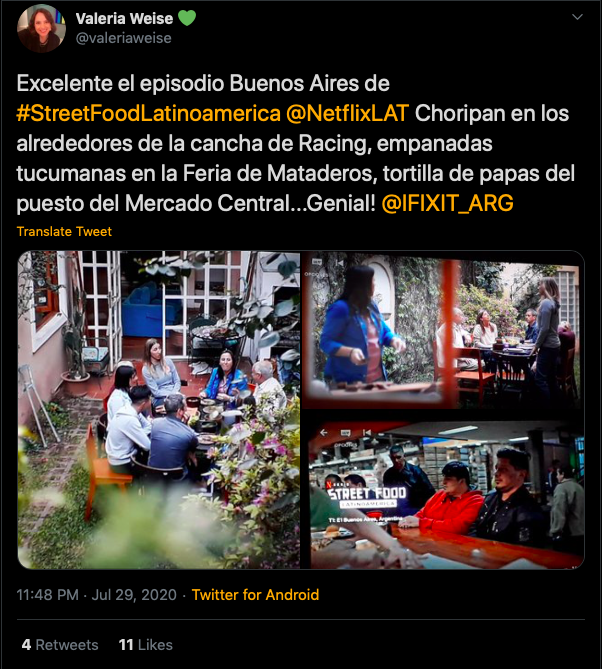
But what caught my eye was the most retweeted of all comments.
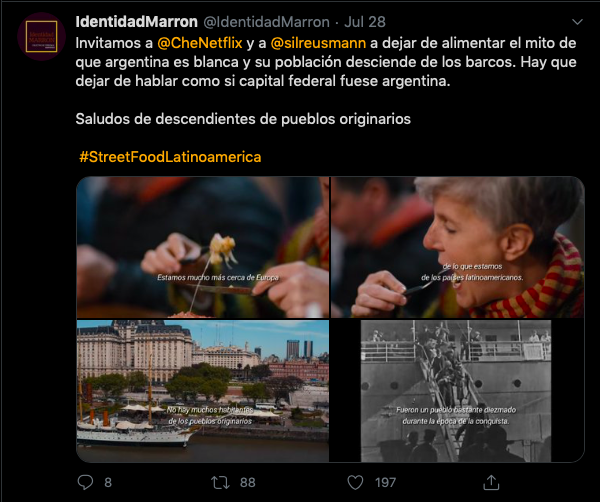
The Narrative
Except for the episode about Brazil, most commentaries are by white experts. Thus, the show frames its narrative with their cultural and historical perspective. Quite a different approach from one that would let other histories emerge. Take, for instance, Stefano Liberti’s reportage, which lends voice to a Guarani Indian chief’s and places his take on history next to the one by Western Brazil’s richest fazenderos, Celso Dal Lago. In it, the Italian journalist lets those two narratives clash to highlight not only the effect of white colonization on native populations’ foods but also the brutishness of the most powerful one.
Street Food: Latin America features people from several different ethnic background, especially women.
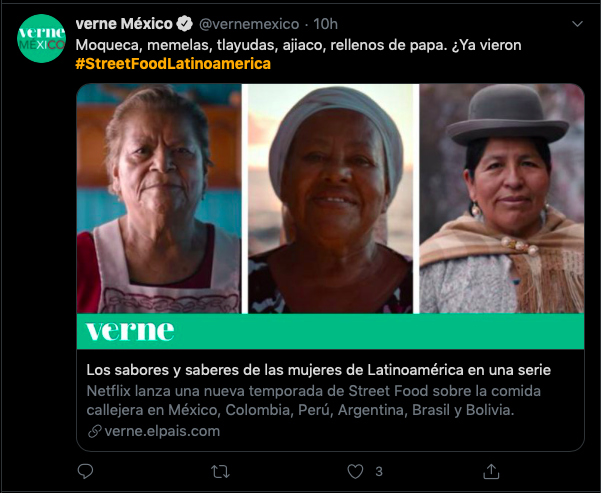
It lets the protagonists tell their stories. However, they always follow the same underdog narrative seasoned with the Disney-Pixar-like uplifting message, “if you work hard enough, you’ll get on top.” That is certainly true for the people featured by the show, but it begs the question: what about the others? Those who despite all their efforts still have no part to play in this model? With regard to this, the series reaches its most honest moment when it portrays Tomás Matsufuji, aka Toshi. Son of Darío Matsufuji, owner of widely acclaimed La Cocina de Darío and emblematic chef of Nikkei cuisine in Peru, Toshi attended private schools before moving to England to pursue a Ph.D. in chemistry. Missing his family and the environment in which he grew up, he moved back to Lima to work with his father. Throughout the episode, Toshi portrays himself and those who work with him as “a band of losers” and his street food restaurant, Al Toke Pez, as an “ugly” place. However, while his narrative unfolds—sprinkling close ups of chopping knives, lavish fires, craving customers, warm-colored walls—his ironic look in his face reveals the marketing ploy behind the front.
Street Food: Latin America displays all the elements you’d expect from this type of show. The camera rapidly shots at people eating, drinking or nursing, tasting and sampling, trying, appreciating, sharing, and picking at tlayudas or gobbling up and feasting on fugazzetas, while everyone around them (chefs, culinary experts, journalists, scholars) talks, describes, comments, judges, shares, imagines, dreams of those foods.
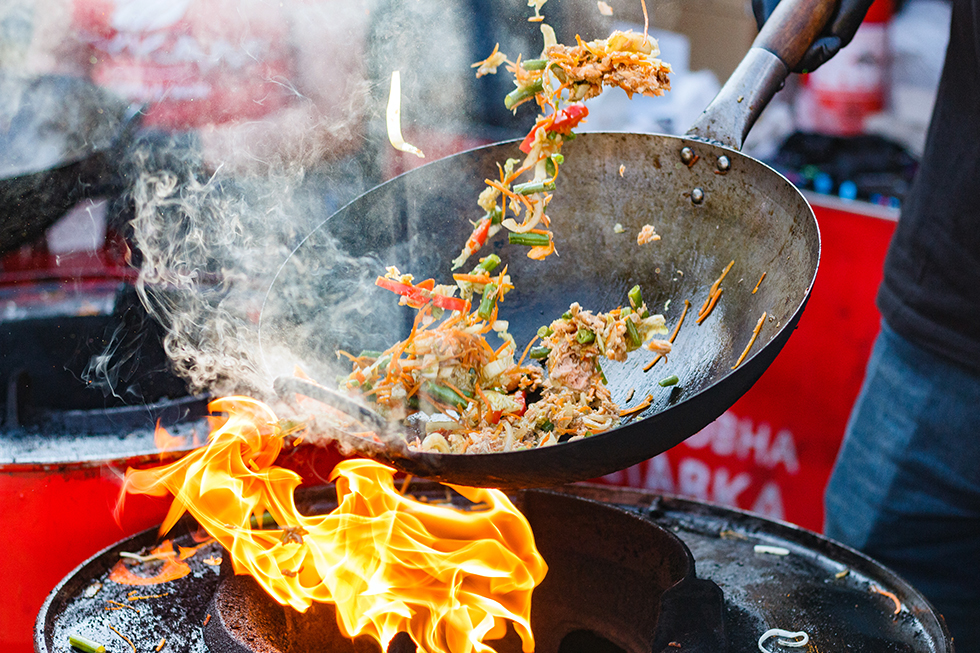
Cameras follows chefs as they bustle around in the kitchen, fry, brown, sauté, pan-fry, sweat, coat in breadcrumbs, boil, while the audience at home can enjoy vegetables, meats, fish, and herbs squeak, creak, and groan, crackle, sizzle, hiss, fizz, and jump surrounded by flames before the acme of the first bite.
In the era of cooking shows, chefs embody a new kind of social hero, a herald of aesthetic and moral values. Carrying with then this social recognition, chefs get out the their kingdoms and join their audience to become “one of us.”
Street food chefs have gone one better and brought their kitchens to the streets while allowing us to reach a new level of intimacy with them. While we follow them purchasing ingredients at the market, the rethoric of authenticity dribbles throughout (if it’s not bought in a supermarket, it must be genuine, right?), with all the ethical flavors that come with it. Moreover, the kitchens fully open at street level with almost no separation between chefs and people, eating customers (unwillingly?) immerse themselves in a Pirandellian situation and become part of the show where eating satisfies both physical and psychological needs (nutrition, recognition, and belonging).
I loved watching the show, learning about new foods and recipes, and I’d definitively want to try them. I admired people’s stories of resilience and success. However, by flattening the richness and diversity of these cultures with its gooey ideology, Street Food: Latin America let me go hungry for genuine representation.


